Description of golden currant and care for it

Currant is one of the most common crops grown on the domestic territory. If black and some other varieties of it are popular and quite famous, then golden currants are preferred much less often.
It is often used not only for its fruit, but also as a landscape element.... Read everything about what it is, its characteristics, planting methods, combination with other plants and care in this article.

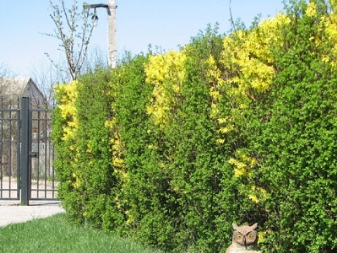
Description and characteristics
Golden currant is a perennial deciduous shrub from the Currant genus and the Gooseberry family. The bush got its name due to the presence of a large number of yellow flowers. According to another version, the shade of the fruit of this currant is also the reason for this name. The berry of the bush is not yellow, but transparent. Therefore, the effect of a golden hue is created.
A shrub usually has many stems. The largest number of shoots is located on the central stem. The bark on the branches is red. The leaf has three or five lobes, very similar to the gooseberry leaf. It tolerates drought well, while other varieties require abundant watering. The shrub height usually reaches 2-2.5 meters. The annual growth of shoots is 30-40 cm.The root system goes deep into almost 1.5 m. Golden currants usually bloom in May, for 2 or 3 weeks. Fruiting occurs in the middle of summer. Fruit diameter is about 1 cm. Fruits are similar in taste to blueberries.
Golden currant tolerates dryness and frost well. Resistant to diseases and pests.

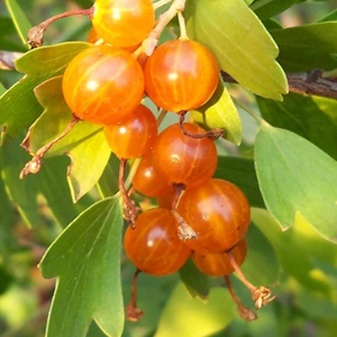
History of appearance
Initially, the "golden" currant grew only in North America and Canada. In Canadian cities, it can still be found in every garden. It came to the domestic territory relatively recently - at the end of the 19th century. However, in those days, the variety was not liked by gardeners. Everything changed when Michurin started breeding. It was the first Michurin golden currant (a variety called "Crandal's Seed") that became the starting point for the widespread cultivation of crops by gardeners and summer residents.
On the basis of this variety, other varieties began to be bred. A feature of these varieties is their high resistance to frost and drought. Also, varieties of golden currant relatively easily and quickly adapt to all climatic conditions of the domestic territory. At the moment, this bush grows not only in Russia, but also in Asian countries, and is also common in Europe.

Varieties
Various varieties of golden currants can produce not only fruits of the same color. Berries can be black, golden and even red. There are quite a few varieties, but the most popular ones are as follows.
- Black Kishmishnaya. One bush can produce up to 10 kg of berries. The berries weigh about 3 g and can be picked in clusters of 10. The berries are black, about 10 mm in diameter. There are no seeds in the fruits.
- "Kishmishnaya raspberry". From a bush, you can get up to 12 kg of berries in 1 year. The berries weigh about 4 g and contain no seeds. Raspberry-colored fruits with juicy pulp.
- "Siberian Sun"... The most famous variety of golden currant, as it produces fruits of a golden color and its flowers are the same. The fruits are relatively small - only about 2.5 g. The annual harvest is 5 kg.The variety tolerates cold, drought well, and is resistant to pests and diseases.
- "Isabel". This variety produces dark brown and sweet and sour berries. It resists diseases well. One bush can produce about 5 kg of berries per year.
- "Laysan"... It tolerates drought, frost and heat well. The berries have a bright golden hue, sweet, but with a slight sourness. It bears fruit well: one bush can give almost 10 kg of berries per year.


Landing
Golden currant is unpretentious, but requires compliance with a number of conditions when planting.
- Seat selection... One of the advantages of this shrub is that it can grow in the shade as well as in the sun. However, currants do not like drafts. On the site, it is best to plant it on the west, southwest sides. A level surface or soil with a slight slope is considered acceptable for planting. Also, you do not need to plant plants near the house or buildings. It is best to plant currants at least one meter from the nearest structure.
- Soil preparation. Before describing soil preparation, I would like to note that this shrub grows on almost any soil: dry, acidic, moist loam, alkaline. However, it should not be planted where the groundwater is too close to the surface (at a distance of less than 1 meter). It is worth preparing the soil for a couple of months for planting. The site is carefully dug up, and then fertilizers are applied to the soil. It will be necessary to apply 6 or 8 kg of compost, as well as 30 g of potassium salt per 1 sq. m. Before digging, the soil is sprinkled with wood ash. During planting, superphosphate (0.2 kg) and a little nitroammophoska are also introduced into the ground.
- Landing scheme... Do not plant currant bushes too close to each other. This is especially true of a permanent place of growth. The distance between adjacent bushes should be 1.5 meters, but on average 1 meter is enough. Keep no more than 3 meters between the rows. If the bushes are very compact, then 2 meters will be enough. As already mentioned, the landing schemes must be drawn up taking into account the distance of 1 meter from the nearest buildings. No need to plant shrubs in trenches. Better to plant each bush in a separate hole. When planting shrubs in trenches, the chances are high that they will interlock with the roots. Plants are planted at a slight slope, and the root collar is deepened by 5 cm. After planting, the soil is tamped and watered.
The seedling is cut so that no more than 6 buds remain on it.


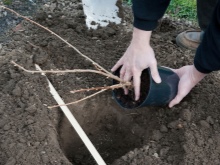
Care
Care for golden currants is not too hard. Even novice gardeners can grow it.
Watering
If the bush is less than 3 years old, then it needs to be watered once a week from early spring to late autumn. For young bushes, a couple of buckets are enough. If the bush is older, then you can water it less often: it will be enough 5 times for the entire growing season.
It is important to water the bushes abundantly while the fruit is forming. Adult bushes need 3-4 buckets of water per watering. Irrigation is recommended to be done through furrows. In especially dry periods, watering should be increased so that the plant does not die or the entire crop does not die. Large plantations of currants are watered by sprinkling.

Top dressing
Due to the peculiarities of the bush (high resistance to diseases, pests and specific weather conditions), top dressing is not necessary. However, it is best to fertilize the soil in which the seedlings are placed. This feeding is enough for a couple of years. Three-year-old bushes begin to be fertilized with manure, poultry droppings and mineral fertilizers.
In the spring, nitrogen is added, in the fall - compost or humus.

Pruning
The easiest way is to prune young bushes. The formation of the bush begins from the second year after planting. Sick branches and all the rest up to 5 buds are cut off. In the spring, the tops are cut off from strong basal shoots of three-year-old bushes. Further, only anti-aging pruning is carried out. Getting it right is pretty easy.
You need to visually divide the bush into four parts and cut one of the root parts every year. Thus, the bush will always remain young, there will be no old branches on it. In addition, sanitary pruning should be done annually in spring and autumn. This procedure involves removing dried, frozen, broken and diseased branches.

Protection against diseases and pests
As a rule, golden currants rarely get sick and are rarely attacked by parasites. To prevent the occurrence of parasites, you need to regularly remove fallen leaves from under the bush. You can also pour boiling water over sleeping bushes in spring.
If the bush is sick with powdery mildew, then in early spring (before bud break) it is sprayed with Nitrafen solution. For the solution, take 200 g of the drug and dissolve in 10 liters of water. It is recommended to spray not only the leaves, but also the soil around the bush. The preparations "Decis" and "Confidor" or other similar insecticides help from aphids.
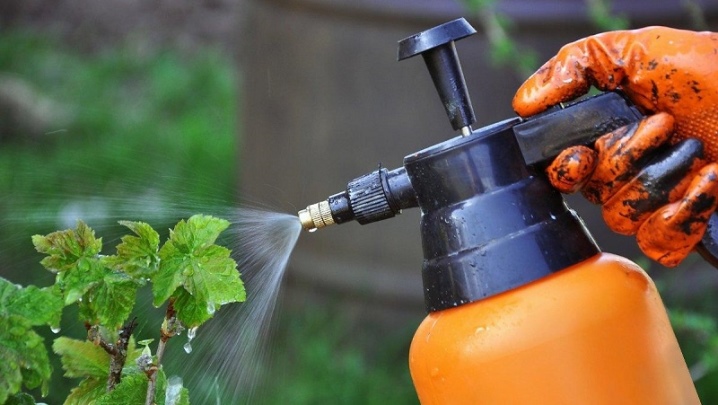
Reproduction
Golden currant reproduces, like any other, relatively well. Usually about 70-80% of all seedlings take root.
Seeds
Seed propagation in the case of golden currants gives poor results. Seed-grown specimens rarely inherit the characteristics of the parent plant. The seeds are practically not found commercially, so this method is largely not used.
Cuttings
The easiest way to propagate currants is by cuttings. Cuttings are small stumps or cut twigs up to 30 cm long. Reproduction can occur both by green cuttings and lignified. When propagated by green cuttings, specimens of the current year are taken. The twig should be relatively flexible. Cuttings are taken from the middle of the twig, their length should be about 12 cm. There should be a bud at a distance of about half a centimeter from the bottom cut. The upper cut should also be made at the same distance from the kidney. Cuttings are dipped in slices into growth activators for 12 hours. Then they are planted in the greenhouse. The cuttings should be watered frequently and abundantly, and also be in the shade. They also need to be sprayed regularly. Cuttings take root after 2 or 3 weeks. A year later (next spring) they are planted on the site and already six months later (in the fall) - at their permanent place of growth.
For propagation by lignified cuttings, last year's shoots are used. They are prepared in advance. When planting in spring, cuttings are cut back in the fall. The slices are dipped in paraffin, then wrapped in a damp cloth and polyethylene. Then, in this form, they are buried and left for the winter under the snow. With the onset of spring, cuttings are planted in a greenhouse or on a plot at an angle of 45 degrees. The distance between the cuttings should be about 20 cm. 2 buds should remain on the surface. Planted cuttings require good watering and mulching. Immediately after planting, they are covered with film or bottles until the moment when the first leaves appear.
With the onset of autumn, it is imperative to transplant the currants to a permanent place.

By dividing the bush
Reproduction in this way guarantees the inheritance of all the traits of the mother bush. Also, this method is good because the transplant can be carried out both in the spring and in the fall. And the efficiency will not suffer from this.
To carry out reproduction by dividing the bush, you first need to dig up the parent specimen. This must be done carefully, trying not to damage the root system. The root ball is divided into 2 or 3 parts using a sharp knife. When dividing the root, you need to make sure that shoots of different ages grow from each part. In this case, the old branches must be completely deleted.... Parts of the root ball are planted in other places, which must first be dug up and mixed with humus. One fourth of the humus is usually sufficient.
Layers
This method guarantees high vitality and a high probability that the new bush will take root. To propagate golden currants by layering, you need to choose a two-year shoot in the spring, which is lowered to the ground more than anyone else. A small groove is made next to the mother bush, and then this shoot is placed in it. In this case, more than 20 cm of the branch should remain above the ground. The branch is also pinned to the ground by installing a metal bracket.
At this point, the main stage of reproduction by layering ends. After the procedure, the plant requires abundant watering. If the layering has taken root, then in the fall it is separated from the main bush and planted in a place of constant growth.

Compatibility with other plants
Good golden currant tolerates the neighborhood with honeysuckle and yoshta. The best neighbor is a gooseberry or other currant bush. Of the trees, the plant goes well with the apple tree. Gardeners consider such a tandem to be good, and also note that it can last for a very long time. Low-growing plants grow beautifully next to golden currants: onions, garlic, various herbs.
Strawberries and wild strawberries feel good next to currants. However, this can cause some difficulties when harvesting undersized plants. Garlic and onions scare away bud mites, which like to dwell on bushes.
Golden currants have a beneficial effect on nightshade crops (tomatoes, peppers, and so on).


Use in landscape design
If ordinary currants are planted to obtain fruits rich in vitamins and minerals, then golden currants are also planted as part of landscape design.... The main use in landscaping is that golden currants are planted as a hedge. With the onset of autumn, the bushes are painted in different shades. Overgrown copies protect not only from annoying passers-by and neighbors, but also from the noise of cars. Golden currants lend themselves well to shaping, so hedges can be shaped in many ways. You can also leave it to grow if getting fruit is not your primary concern.
This plant attracts attention and can focus on one or another part of the site. It looks especially good on the lawn alone. Currants can also be made the centerpiece of a flower arrangement by surrounding it with shorter plants. If there are zones on the site that are unsightly at first glance, then thick bushes of golden currant can block them. They have low soil quality requirements, so they will grow where most plants cannot.
Another unusual use of golden currants is planting next to an apiary. The flowers of the bush are good food for bees, and the honey is very aromatic and tasty.
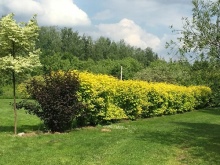









The comment was sent successfully.